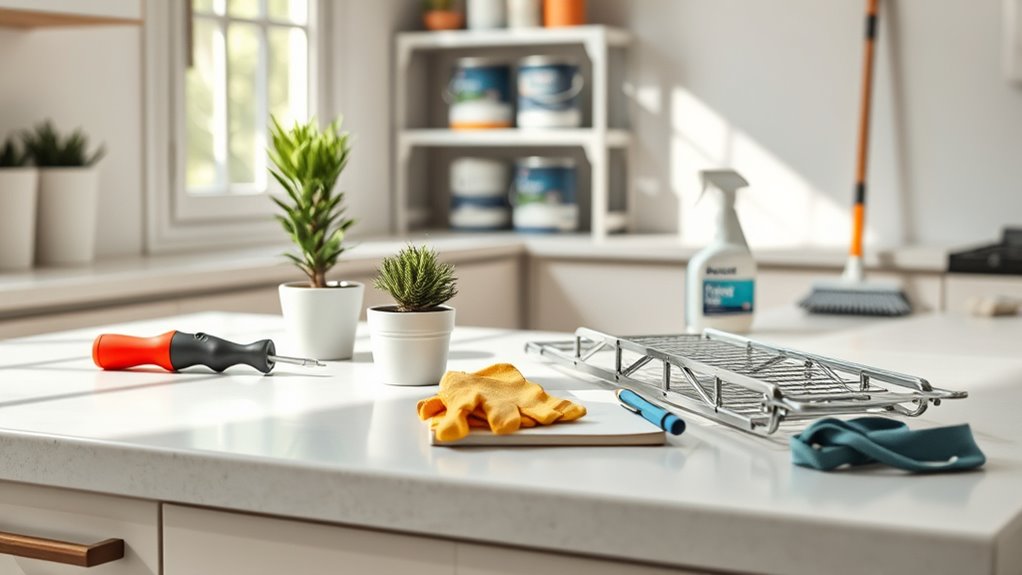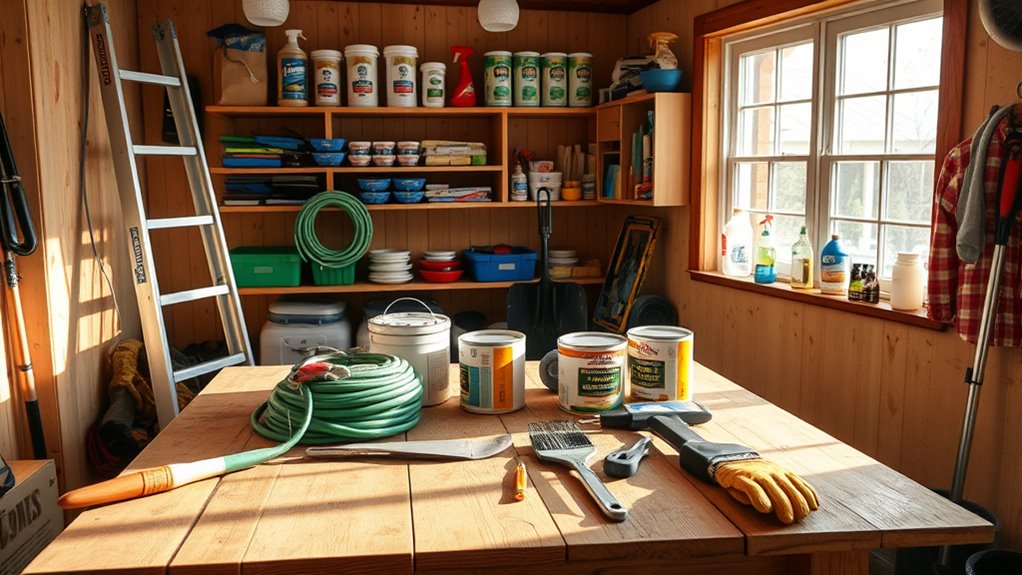To keep your home in top shape year-round, tackle seasonal tasks like inspecting your roof in spring, cleaning gutters in summer, sealing cracks in fall, and checking insulation in winter. It’s also smart to maintain HVAC systems, clear debris, and prevent pipes from freezing, depending on the season. Staying consistent with these chores can save money and keep your home safe. Keep exploring to find more tips and detailed checklists for each season.
Key Takeaways
- Conduct seasonal inspections of roof, gutters, windows, and doors to identify damage and improve energy efficiency.
- Perform cleaning and maintenance tasks specific to each season, such as gutter clearing in spring or insulation checks in winter.
- Address minor repairs early to prevent costly damage and maintain home safety and functionality year-round.
- Prepare outdoor areas by trimming, clearing debris, and draining hoses to prevent weather-related damage.
- Review and update your home maintenance checklist seasonally to stay organized and ensure all tasks are completed timely.

Have you ever wondered if your home is as well-maintained as it should be? Keeping your house in top shape requires regular attention, especially when it comes to seasonal inspections. These inspections help you catch potential issues early before they become costly repairs. One of the best ways to handle routine upkeep is through DIY repairs whenever possible. By taking the initiative to fix minor problems yourself, you save money and gain a better understanding of your home’s needs. Whether it’s tightening loose fixtures, fixing leaky faucets, or replacing weatherstripping, tackling these tasks on your own keeps your home running smoothly.
Regular home maintenance and DIY repairs keep your house in top shape and save you money.
When the seasons change, it’s crucial to perform a thorough inspection of your property. In spring, check your roof for any damage caused by winter storms. Clear out gutters and downspouts to prevent water backup, and inspect your windows and doors for drafts. These seasonal inspections ensure your home is prepared for the warmer months and help maintain energy efficiency. Summer calls for evaluating your air conditioning system, cleaning filters, and trimming overgrown landscaping that could block vents or create moisture issues. Fall is the perfect time to seal cracks around windows and doors, clean your furnace filters, and drain outdoor hoses. By conducting these inspections and maintenance tasks before winter, you reduce the risk of heating problems and water damage when temperatures drop.
Winter maintenance should focus on protecting your home from freezing temperatures. Check your attic insulation to prevent heat loss, and ensure your pipes are insulated to avoid freezing and bursting. Test your smoke and carbon monoxide detectors, and replace batteries if necessary. Performing these seasonal inspections helps keep your home safe and energy-efficient during the coldest months. Additionally, understanding the importance of contrast ratio can help you evaluate your home’s heating and insulation effectiveness, ensuring your space stays warm and comfortable. Performing these seasonal inspections and maintenance tasks helps keep your home safe and energy-efficient during the coldest months. As winter ends and spring approaches, revisit your checklist to identify any repairs needed from winter wear and tear. This cyclical process ensures your home remains resilient and comfortable throughout the year.
Incorporating DIY repairs into your seasonal routine not only saves you money but also gives you peace of mind. You become more familiar with your home’s systems and can address small issues before they escalate. Remember, regular seasonal inspections are your best defense against larger, more expensive problems down the line. With a proactive approach, you’ll keep your home in excellent condition, extend its lifespan, and enjoy a safer, more comfortable living space year-round. Taking the time to inspect and perform simple repairs regularly is a smart investment in your property’s future.
Frequently Asked Questions
How Often Should I Replace HVAC Filters?
You should replace your HVAC filter every 1 to 3 months, depending on its lifespan. Regular replacements help maintain ideal airflow and improve air quality, which is essential for your health. If you have pets or allergies, consider changing filters more frequently. Keeping an eye on the filter’s condition ensures it doesn’t become clogged, allowing your system to run efficiently and providing cleaner, healthier air in your home.
What Are Signs of Roof Damage After a Storm?
Imagine your roof as a shield guarding your home’s heart. After a storm, look for visible signs of damage like missing shingles, cracked tiles, or dents—these are your clues. Water stains or leaks inside also signal trouble. Conduct a thorough roof inspection to catch hidden damage early. Recognizing storm damage promptly helps you repair the shield before bigger issues threaten your home’s safety and comfort.
When Is the Best Time to Inspect Plumbing for Leaks?
You should schedule a plumbing inspection and leak detection at least once a year, ideally before winter or after heavy storms. Regular inspections help catch leaks early, preventing water damage and costly repairs. Check under sinks, around toilets, and near appliances for signs of leaks. Prompt leak detection keeps your plumbing in good shape, saves water, and avoids unexpected emergencies. Don’t wait—routine inspections are essential for maintaining a healthy home.
How Can I Prevent Mold Growth in Humid Seasons?
Imagine your home as a lush garden; mold thrives like weeds in damp, humid corners. To prevent mold growth during humid seasons, you should focus on mold prevention by controlling humidity levels with dehumidifiers and exhaust fans. Keep surfaces dry, fix leaks promptly, and ensure good air circulation. These steps act as a shield, protecting your home from mold’s silent invasion and keeping your living space fresh and healthy.
What Tools Are Essential for Seasonal Home Maintenance?
You’ll want essential tools like a screwdriver, hammer, and pliers for seasonal home maintenance. These help with DIY projects that improve your home’s energy efficiency, such as sealing gaps or replacing weatherstripping. A ladder makes it easier to reach high areas for gutter cleaning or inspecting the roof. Don’t forget a flashlight for dark spaces. Having these tools on hand guarantees you can tackle seasonal tasks efficiently and keep your home in top shape.
Conclusion
Sticking to this seasonal home maintenance checklist is like tending a garden—you’ll see your efforts grow into a cozy, well-cared-for home. By staying proactive, you prevent small issues from turning into big problems. Make these tasks a routine, and you’ll enjoy peace of mind all year round. Remember, a little upkeep now keeps costly repairs at bay, so embrace each season’s chores and watch your home flourish like a beautiful, thriving landscape.










